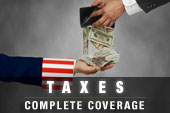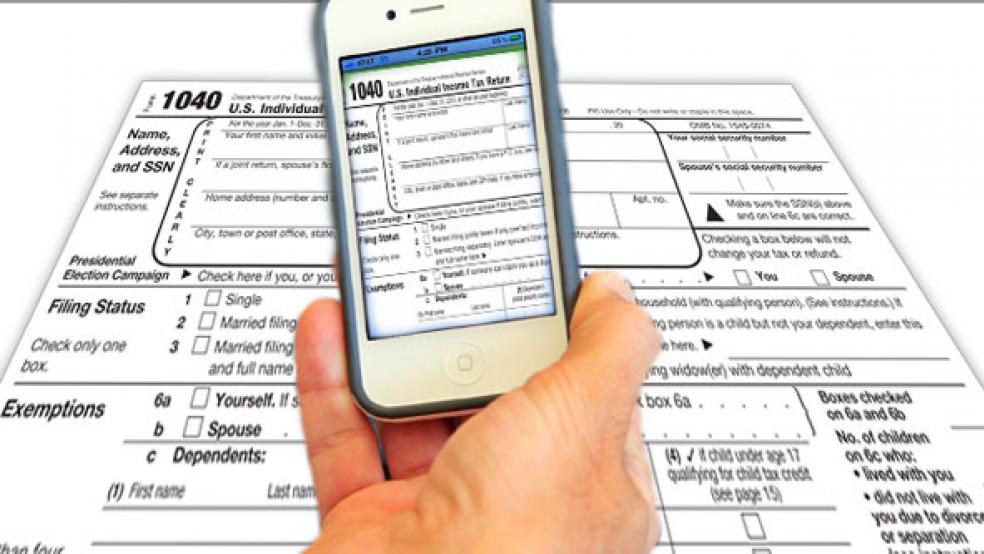No one denies the need to simplify the tax code. It is sprawling, obtuse, and an absolute time suck for millions of Americans—something not lost on House Republicans when they unveiled their 2014 budget proposal last week.
“Today, the tax code is nearly 4 million words long,” Rep. Diane Black, R-Tenn., said at the budget announcement. “And about 60 percent of our taxpayers need to hire a professional to help them to prepare their returns. Every year, Americans spend six billion hours and $160 billion filling out their returns. Clearly, something is wrong.”

This rationale—one also showcased in previous proposals by House Budget Committee Paul Ryan—is both accurate and somewhat disingenuous.
Even if Republicans and Democrats partnered to slim down the tax code, it would continue to be an absurd hassle to meet the April 15 deadline. Many taxpayers would still cull through countless receipts and fret over confusing forms, rather than effortlessly file with the IRS and settle into a “House of Cards” marathon.
“If it were that easy, we would have done it long ago,” explained John Ams, executive vice president of the National Society of Accountants,whose 30,000 members deal with tax and estate issues for 19 million Americans. “The problem is we started out with a simple system and then we decided to do all this social engineering.”
The trouble is that the government relies on the tax code to encourage certain behaviors: buying a home, paying for college, saving for retirement, donating to charity. Those actions may all seem reasonable in the scheme of things, while other behaviors seem downright wacky.
Americans generally like tax deductions, but each one creates a potential loophole to be exploited.
Ams used the example of the $8,000 tax credit for first-time homebuyers to outline how the tax code gets inundated with small print.
Imprisoned convicts start claiming the credit, he said, so then the government requires that it only apply to a principal residence. Once that loophole is closed, an existing homeowner finds a way to route the purchase of another house through his two-year-old child to reap the benefits of the tax credit. The abuses only add to the heft and complexity of tax laws.
“My fear is that we can’t be as simple as we would like,” Ams said.
Almost 90 percent of taxpayers hires an accountant or relies on tax preparation software, according to the 2012 annual report by the government’s Taxpayer Advocate Service. It costs, on average, $246 for a tax expert to prepare an individual filing and the leading online programs cost $50 or more.
But accountants, and the companies that produce computerized tax programs, don’t worry that a simpler code would lead them to lose clients. It’s a sign that even if tax regulations were sliced in half, they would still be intimidating for most of us.
“We have long been a proponent for tax simplification,” said Julie Miller, a spokeswoman for Intuit, the maker of Turbo Tax.
Intuit’s reasoning is that the government can only do so much to clean up the tax code and that a competitive market gives companies an incentive to development better tax filing products.
“Innovation in the private sector will be a key lever to making taxes simpler and easier to do,” Miller told The Fiscal Times. “It’s something we take very seriously.”
Through the Free File Alliance, several tax software companies including Intuit partner with the IRS to help Americans below a certain income threshold submit their returns without a charge. But broader efforts by the government to make the tax filing process less painful have met industry opposition.
One alternative to the existing tax industry was floated by The New York Times in 2010. It explained that the IRS could send taxpayers their returns that were already partially completed, since the government has access to much of the data. President Obama even supported the “option of pre-filled” returns in the 2008 campaign. That possibility never had a major chance of clearing Congress.
The main source of confusion, however, continues to be the maze of deductions and credits, which are politically popular—most prominently the mortgage interest deduction—and unlikely to be removed.
In proposing his budget, Wisconsin Congressman Ryan noted that upcoming committee hearings would identify the tax breaks to protect as part of his plan to simplify taxes into two brackets of 10 percent and 25 percent.
Or, for example, when the fiscal cliff deal passed earlier this year that raised rates on the top one percent of earners, President Obama noted with pride the tax breaks contained in the agreement.
“We extended tax credits for families with children and tuition tax credits that are helping millions of families pay for college,” said Obama, even though the measure also contained highly-targeted tax gimmes for NASCAR and Hollywood.
The president’s statement unwittingly explains both the difficulty of simplifying the tax code and the need to do so.
There are 14 different educational deductions and credits that have been put into the tax code since its last major overhaul in 1986 and caused confusion, said Don Longano, a former Democratic Counsel at the House Ways & Means Committee who is chairman of the American Institute of CPA’s task force on tax reform.
The credits are so complex that about 14 percent of filers with education expenses failed to claim them—at an average tax benefit loss of $466, according to a review of 2009 filing data by the Government Accountability Office.
It’s this kind of frustration—self-defeating tax breaks—that make the case for simplification so compelling, yet the chance of realizing that goal so remote.
“Wouldn’t the ideal be where a typical individual could do their return, and could understand what goes into their return without having to use over-the-counter software?” said Mel Schwarz, director of tax legislative affairs at the accounting and advisory firm Grant Thornton. “That, more than anything else, may be one of the reasons why there is need for tax reform. People need to understand how their economic behavior is affected by tax policy.”




